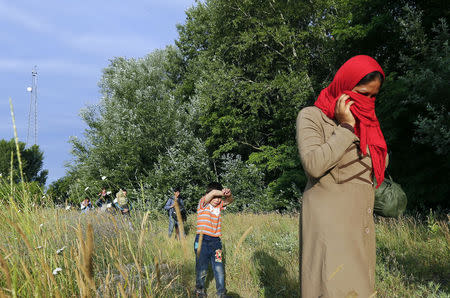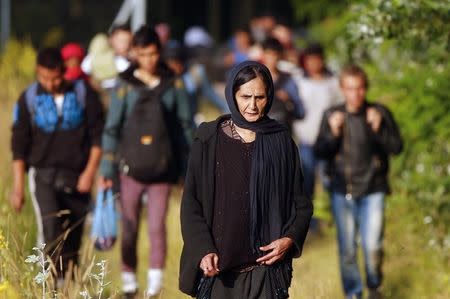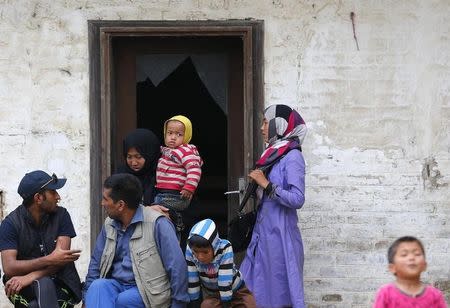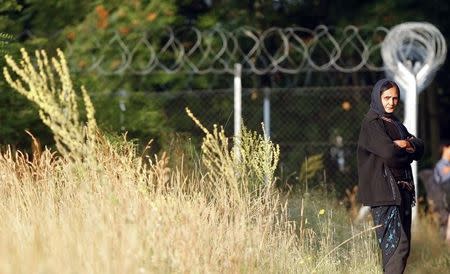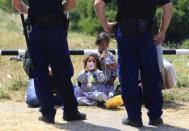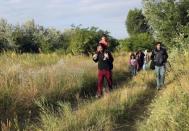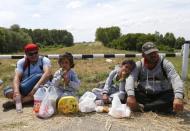Among meadows and cherry trees, the new migrant gateway to Europe
By Krisztina Than and Aleksandar Vasovic SERBIAN-HUNGARIAN BORDER (Reuters) - Covered in mosquito bites from nights spent out in the open, two girls from Syria, one six and one eight, lay on blankets in a grove of cherry and apricot trees in northern Serbia waiting for the next leg of their long journey to begin. In a few hours, the girls, in matching grey track suits with the word "Hollywood" in blue lettering across the chest, would set off with a group of other migrants to try to cross illegally into Hungary. If they make it, they would -- after what for many migrants is months of travelling -- be in the European Union, with a chance of being granted asylum or, failing that, of melting into the vast border-free space and building a new life. "I must go to Germany," said Iara, a 22-year-old from the outskirts of the Syrian capital, Damascus, who was in the same group as the two young girls in the track suits. The group hunkered down in the orchard are some of the nearly 70,000 migrants who illegally crossed the Serbian-Hungarian border so far this year. That flow has meant the fields and flood plains around the river Tisza, which meanders around the border, have become the new frontline in the EU's struggle to cope with illegal migration. Hungarian Prime Minister Viktor Orban has ordered construction of a four-metre high fence to keep the migrants out. Unlike the tide of migrants crossing the Mediterranean in rickety boats, few people die here, so the spot garners less attention. But it this year overtook Italy as the biggest entry point to the EU for illegal migrants. "We were talking so far about Italy and Greece. Now we've added Hungary," the European Commissioner for migration, Dimitris Avramopoulos, said in the Hungarian capital on Tuesday. MAKESHIFT CAMPSITES The migrants have turned this quiet, mostly rural corner into a teeming clandestine thoroughfare. In the tall, grass near the border, the chirping of birds mixes with the faint sound of human voices. The thick undergrowth opens up to reveal makeshift campsites were people rest up before heading over the border. Hashmat, 18, said he left Afghanistan three months ago. He has been staying in the fields near the Serbian town of Subotica for six days and now he plans to cross into Hungary. "Our country is very demolished," Hashmat, wearing a grey jacket and blue shirt, said in broken English. "I go to Germany." At the bivouac sites abandoned by people who since moved on, there are discarded pieces of clothing, T-shirts in rags, empty plastic bottles, and dirty diapers. This spot is near the end of a long, weary path for the migrants. Many of them first got to Turkey, and then made the hazardous boat crossing to land illegally in Greece. Once on Greek soil they are inside the EU but for most the preferred destination is in Europe's prosperous north, countries such as Germany and Sweden, so they strike out again using the most direct route. They make the overland journey -- some of it on foot -- from Greece into Macedonia, then on to the northern edge of Serbia to attempt to cross the border. Strewn on the ground are traces of the path the migrants have taken to get here, documents in Greek and Macedonian, and Serbian certificates lying scattered near the cold embers of a fire. "This is to certify that the bearer of this document is an asylum seeker who must report to the Asylum Centre... within 72 hours," a document stated. Migrants fear if they are caught inside the EU with documents showing they are already registered as asylum seekers elsewhere, that could be grounds for them to be sent back. FLEEING CONFLICT As midnight approaches - and the chances of being stopped by police or border guards recede - the migrants get ready to set off across the border. At Kanjiza, a village just off the Tisza river, small groups of Syrian men gather in the main square. Ahmed Mustafa, 30, is Kurdish, and said he comes from the Syrian town of Kobani, which has been under siege from Islamic State fighters. He left Syria after his brothers were killed, he said. He showed photos on his mobile phone of children's corpses. He said he wants to reach the Netherlands. Danny, 25, from Damascus, said he walked some 500 km (300 miles) from Turkey to the Hungarian border, and hopes to find work as an aviation engineer in Germany, Europe's biggest economy where established immigrant communities offer support. He said walking such long distances was not a problem for him or his friends because they are fit and strong. "But in Macedonia... children walked with us," he said. INSIDE THE EU Dawn arrives, and knots of migrants who started the night on the Serbian side are starting to emerge on Hungarian territory. Shortly before 7 a.m., a group of about 30 Afghan men and women, some carrying babies, cross through the bushes and over a trench. After walking for about four hours, they have finally set foot in Hungary, and the European Union. They quickly disappear into the grass along a dirt road in the morning light. At a different section of the border, the two Syrian girls in the "Hollywood" track suits, accompanied by two male adult migrants, walk along the top of a dam across the Tisza river. Police officers stop them, and they sit down on the ground, exhausted, surrounded by the plastic carrier bags they brought with them. The police hand them some bottled water. The six-year-old girl gets out a tiny pink bottle, dips a plastic wand inside and blows soap bubbles. After a while a police van arrives at the dam. An officer approaches the group and says politely to them in English: "Hello, stand up." The girls, wave, and say "hello". They stand and get into the van, the six-year-old now eating a peach, with her bubble toy hanging from a string around her neck. The van was heading to a nearby camp for migrants where they will be registered, and then allowed to leave. Another leg of their journey is complete: they are in Hungary, inside the European Union. (Editing by Christian Lowe and Philippa Fletcher)

 Yahoo News
Yahoo News 